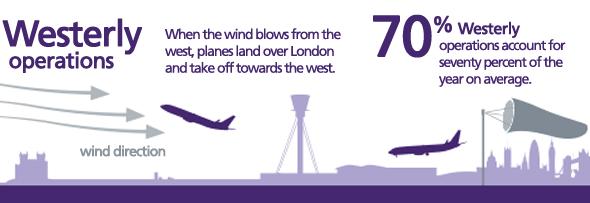
The direction planes fly at Heathrow depends on the direction of the wind. For safety and performance reasons aircraft typically take off and land into the wind. This is because an aircraft’s wing relies on the speed of the air moving over it (airspeed) to lift it off the ground.
When winds are light (below 5 knots – about 6 miles per hour) aircraft can potentially take off or land in either direction. Rules are set by Government to determine what to do in these circumstances. These are called a "directional preference" and they say in which direction operations should be when the winds are light and there is a choice. At Heathrow, winds are light on average 20% of the time.
During the day, a ‘westerly preference’ is operated at Heathrow. This is Government policy and means that even during periods of light easterly winds aircraft will continue to land in a westerly direction, making their final approach over London. This was introduced in the 1960s to reduce the number of aircraft taking off in an easterly direction over London, the most heavily populated side of the airport. This was when departures were considered to be more disruptive to local communities than arrivals.
In the UK, the wind is mostly from the south west. That means that with a westerly preference in place the majority of aircraft (approximately 70% a year) arrive from the east (over London) and take off towards the west (over Berkshire/Surrey). This is known as ‘westerly operations’.
When the wind blows from the east (and is over 5 knots), the direction of operation is switched and aircraft land from the west over Berkshire and take off towards the east. This is known as 'easterly operations' and occurs approximately 30% of the time.
Following consultation in 2001, the Government decided that the westerly preference should be removed at night and particularly during the early morning period when there are more arrivals than departures. This means that instead of westerly preference at night, we rotate between westerly and easterly operations to provide a fairer distribution of aircraft noise to the east and west of the airport. We can only do this when the wind direction allows us to or is below 5 knots.
The percentage of westerly and easterly operations varies from week to week and month to month. We provide live updates on the direction Heathrow is operating via our dedicated X channel (follow us @HeathrowRunways).
The direction of operation is determined by NATS air traffic controllers who monitor wind speed and direction on the airfield and at different levels up to 3,000ft. The position is kept under constant review. The weather forecast is not always a reliable indicator of what is happening at Heathrow since the Met Office forecast for the public relates to ground level.
Due to the direction of operation being determined by the wind, the operation can change direction more than once in a day. We are therefore unable to control or predict which direction the airport will be operating in.

